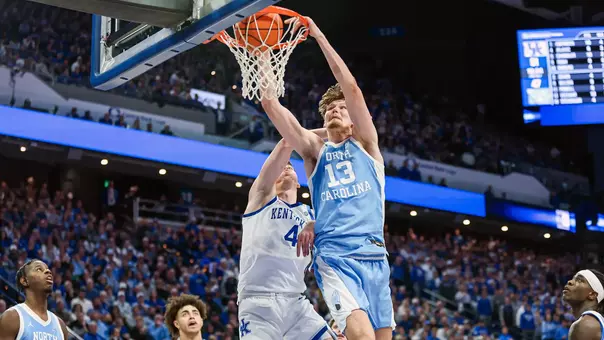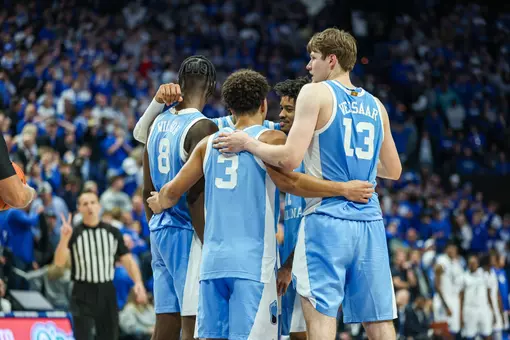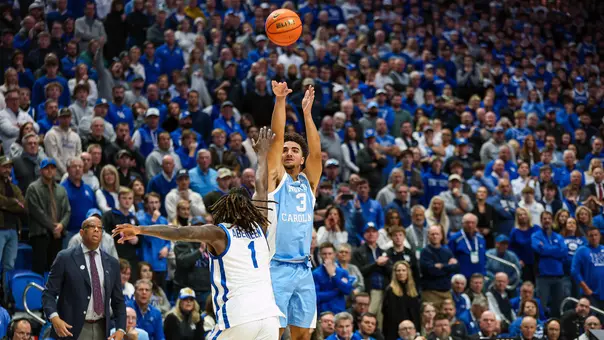University of North Carolina Athletics

Lucas: The Sixth Borough
December 5, 2023 | Men's Basketball, Featured Writers, Adam Lucas
Carolina teams have excelled with New York representation, and New York representatives have excelled in Chapel Hill.
By Adam Lucas
Hubert Davis was right.
From his initial weeks on the job in the spring of 2021, Davis had been adamant about returning North Carolina to a place of prominence in New York basketball. It makes sense. After all, when he played for the New York Knicks, he was the only member of the team who actually lived inside the city—96th St. between 3rd Ave. and Lexington, as he fondly remembers.
But all of Davis' New York memories aren't Knick-based. Instead, they go all the way back to his freshman season at Carolina, when the Tar Heels played in a loaded Preseason NIT in November of 1988 that included Syracuse, Missouri and Indiana (current assistant coach Jeff Lebo dropped a career-high 29 in a way over Bob Knight's Hoosiers at the Garden).
"Coach Smith called me up to the front of the bus, and I sat with him," Davis says. "He talked to me about New York. I remember it like it was yesterday. He showed me Times Square, the Empire State Building…my mouth was wide open. I had never been to New York before and I had never seen so many tall buildings and lights."
In his first season as head coach, the Tar Heels did get to play in the ACC Tournament in Brooklyn. But he wanted a Tar Heel-specific date in the Big Apple, and he preferably wanted it to be at Madison Square Garden. "I want every Carolina player to say, 'I played in the Garden,'" Davis said. "That's a big deal."
The head coach got his wish last year when Carolina faced Ohio State in the CBS Sports Classic, earning a pulsating victory after Pete Nance swished a jumper at the end of regulation and the Tar Heels prevailed in overtime.
The crowd was as notable as the victory. Even with fans of four teams in the building, Carolina easily had the best representation, emphasizing Davis' assertion that New York City was a Tar Heel stronghold. "It felt like the Smith Center in there," Davis said. "There was so much Carolina blue."
As Davis well knows, Carolina's relationship with the New York City metropolitan area predates even Dean Smith. It all started with Frank McGuire. Carolina persuaded the consummate New Yorker to leave St. John's for Chapel Hill in 1952, and he immediately began importing the city's best players.
The key recruiting moment happened with the class that entered in the fall of 1953. Although freshmen weren't eligible due to NCAA rules, McGuire stocked his roster with New York natives, where he had numerous recruiting contacts who gave him a constant presence in the city even when he was in Chapel Hill.
Although Lennie Rosenbluth would go on to a highly decorated career (NC State head coach Everett Case told Rosenbluth, "We only have one scholarship left, and don't want to waste it," forever altering basketball on Tobacco Road), it was Joe Quigg—who enrolled a semester earlier—who was the centerpiece recruit of that particular class. With New York City being its own basketball world, it was imperative for the Tar Heels to land one player with a big reputation to persuade others it was an acceptable destination.
"I did end up being kind of like the pied piper for the rest of the guys," Quigg says. "I was down there six months before them, and I spent a lot of time telling them how nice it was. It was a big deal to them to hear that from me, because we had played against each other a lot in the city and they knew I was a New York guy."
There was no question, of course, about whether McGuire was a New York guy. Even around town in Chapel Hill, he relished the attention his New York connections received. The New York World Telegram and Sun ran a cartoon depicting a Chapel Hill subway stop on the New York City subway. The Carolina head coach was delighted—he had two copies framed and hung one in his office and one in his living room at his home on Oakwood Drive in Chapel Hill.
"New York is my personal territory," he boasted to Sports Illustrated. "Duke can scout in Philadelphia and North Carolina State can have the whole country. But if anybody wants to move into New York, they need a passport from me."
It paid off when the New York-heavy 1957 roster went undefeated and won Carolina's first NCAA championship. All five starters—Quigg, Rosenbluth, Tommy Kearns, Bob Cunningham and Pete Brennan—were from the New York metropolitan area, giving the Tar Heels enough talent even to fell the legendary Wilt Chamberlain and Kansas in the triple-overtime national title game.
Although the Tar Heels would not again field an entire team of New Yorkers, even after the coaching transition to Dean Smith they continued to supplement their roster with the very best New York talent. Both of Smith's national championship teams included key players from the area; Matt Doherty (East Meadow, N.Y.), Sam Perkins (Brooklyn and Latham) and Jimmy Black (Bronx) were starters on the 1982 team, while Derrick Phelps (Queens), Brian Reese (Bronx) and Pat Sullivan (Bogota, N.J.) played major roles on the 1993 squad. And although most today connect Michael Jordan with his more commonly listed hometown of Wilmington, he was born in Brooklyn.
Tar Heel basketball history would be completely different without such key figures as Charles Scott (New York City), Larry Brown (Long Beach), Billy Cunningham (Brooklyn), Mitch Kupchak (Brentwood), Mike O'Koren (Jersey City), Kenny Smith (Queens), Danny Green (North Babylon), Ed Cota (Brooklyn) and Cole Anthony (New York City).
"The players in New York are tough," Hubert Davis said. "They have a sense of urgency and competitiveness that you have to have on a team."
This year's team again has a heavy New York flavor. RJ Davis is one of just ten players in Carolina history to score at least 27 points per game in three straight games—and by this point it probably wouldn't surprise you to know that four of the other nine (Rosenbluth, Pete Brennan, Scott and Cunningham) also are New York natives, meaning that fully half the players to accomplish the feat hail from the Empire State.
Notre Dame transfer Cormac Ryan also calls New York City home; both Davis and Ryan are expecting to have dozens of family and friends on hand to watch Tuesday night's game. The constant roster turnover in college basketball has made it virtually impossible to continue Smith's policy of playing at least one "home" game near the hometown of every player on the team, but this year's Garden contest also serves as a partial continuance of that tradition. Elliot Cadeau will also be playing an hour from home but is quick to point out he's a New Jersey point guard, not New York.
No matter how you define the geographic boundaries, it's pretty simple: Carolina teams have excelled when they have New York representation, and New York natives have excelled at Carolina. Fifty-three players have retired or honored jerseys in the Smith Center rafters. Fourteen of those players have New York ties. To give that figure some context, only 12 of the retired/honored players hail from North Carolina.
"I was born and raised in New York City," Ryan says. "With New York players, there's a certain edge and toughness. You can see that in RJ, too. There's a certain air about New York guys. There's some toughness, and I like to think I have that. I grew up in that environment, and I think it has helped me throughout my career."
Hubert Davis was right.
From his initial weeks on the job in the spring of 2021, Davis had been adamant about returning North Carolina to a place of prominence in New York basketball. It makes sense. After all, when he played for the New York Knicks, he was the only member of the team who actually lived inside the city—96th St. between 3rd Ave. and Lexington, as he fondly remembers.
But all of Davis' New York memories aren't Knick-based. Instead, they go all the way back to his freshman season at Carolina, when the Tar Heels played in a loaded Preseason NIT in November of 1988 that included Syracuse, Missouri and Indiana (current assistant coach Jeff Lebo dropped a career-high 29 in a way over Bob Knight's Hoosiers at the Garden).
"Coach Smith called me up to the front of the bus, and I sat with him," Davis says. "He talked to me about New York. I remember it like it was yesterday. He showed me Times Square, the Empire State Building…my mouth was wide open. I had never been to New York before and I had never seen so many tall buildings and lights."
In his first season as head coach, the Tar Heels did get to play in the ACC Tournament in Brooklyn. But he wanted a Tar Heel-specific date in the Big Apple, and he preferably wanted it to be at Madison Square Garden. "I want every Carolina player to say, 'I played in the Garden,'" Davis said. "That's a big deal."
The head coach got his wish last year when Carolina faced Ohio State in the CBS Sports Classic, earning a pulsating victory after Pete Nance swished a jumper at the end of regulation and the Tar Heels prevailed in overtime.
The crowd was as notable as the victory. Even with fans of four teams in the building, Carolina easily had the best representation, emphasizing Davis' assertion that New York City was a Tar Heel stronghold. "It felt like the Smith Center in there," Davis said. "There was so much Carolina blue."
As Davis well knows, Carolina's relationship with the New York City metropolitan area predates even Dean Smith. It all started with Frank McGuire. Carolina persuaded the consummate New Yorker to leave St. John's for Chapel Hill in 1952, and he immediately began importing the city's best players.
The key recruiting moment happened with the class that entered in the fall of 1953. Although freshmen weren't eligible due to NCAA rules, McGuire stocked his roster with New York natives, where he had numerous recruiting contacts who gave him a constant presence in the city even when he was in Chapel Hill.
Although Lennie Rosenbluth would go on to a highly decorated career (NC State head coach Everett Case told Rosenbluth, "We only have one scholarship left, and don't want to waste it," forever altering basketball on Tobacco Road), it was Joe Quigg—who enrolled a semester earlier—who was the centerpiece recruit of that particular class. With New York City being its own basketball world, it was imperative for the Tar Heels to land one player with a big reputation to persuade others it was an acceptable destination.
"I did end up being kind of like the pied piper for the rest of the guys," Quigg says. "I was down there six months before them, and I spent a lot of time telling them how nice it was. It was a big deal to them to hear that from me, because we had played against each other a lot in the city and they knew I was a New York guy."
There was no question, of course, about whether McGuire was a New York guy. Even around town in Chapel Hill, he relished the attention his New York connections received. The New York World Telegram and Sun ran a cartoon depicting a Chapel Hill subway stop on the New York City subway. The Carolina head coach was delighted—he had two copies framed and hung one in his office and one in his living room at his home on Oakwood Drive in Chapel Hill.
"New York is my personal territory," he boasted to Sports Illustrated. "Duke can scout in Philadelphia and North Carolina State can have the whole country. But if anybody wants to move into New York, they need a passport from me."
It paid off when the New York-heavy 1957 roster went undefeated and won Carolina's first NCAA championship. All five starters—Quigg, Rosenbluth, Tommy Kearns, Bob Cunningham and Pete Brennan—were from the New York metropolitan area, giving the Tar Heels enough talent even to fell the legendary Wilt Chamberlain and Kansas in the triple-overtime national title game.
Although the Tar Heels would not again field an entire team of New Yorkers, even after the coaching transition to Dean Smith they continued to supplement their roster with the very best New York talent. Both of Smith's national championship teams included key players from the area; Matt Doherty (East Meadow, N.Y.), Sam Perkins (Brooklyn and Latham) and Jimmy Black (Bronx) were starters on the 1982 team, while Derrick Phelps (Queens), Brian Reese (Bronx) and Pat Sullivan (Bogota, N.J.) played major roles on the 1993 squad. And although most today connect Michael Jordan with his more commonly listed hometown of Wilmington, he was born in Brooklyn.
Tar Heel basketball history would be completely different without such key figures as Charles Scott (New York City), Larry Brown (Long Beach), Billy Cunningham (Brooklyn), Mitch Kupchak (Brentwood), Mike O'Koren (Jersey City), Kenny Smith (Queens), Danny Green (North Babylon), Ed Cota (Brooklyn) and Cole Anthony (New York City).
"The players in New York are tough," Hubert Davis said. "They have a sense of urgency and competitiveness that you have to have on a team."
This year's team again has a heavy New York flavor. RJ Davis is one of just ten players in Carolina history to score at least 27 points per game in three straight games—and by this point it probably wouldn't surprise you to know that four of the other nine (Rosenbluth, Pete Brennan, Scott and Cunningham) also are New York natives, meaning that fully half the players to accomplish the feat hail from the Empire State.
Notre Dame transfer Cormac Ryan also calls New York City home; both Davis and Ryan are expecting to have dozens of family and friends on hand to watch Tuesday night's game. The constant roster turnover in college basketball has made it virtually impossible to continue Smith's policy of playing at least one "home" game near the hometown of every player on the team, but this year's Garden contest also serves as a partial continuance of that tradition. Elliot Cadeau will also be playing an hour from home but is quick to point out he's a New Jersey point guard, not New York.
No matter how you define the geographic boundaries, it's pretty simple: Carolina teams have excelled when they have New York representation, and New York natives have excelled at Carolina. Fifty-three players have retired or honored jerseys in the Smith Center rafters. Fourteen of those players have New York ties. To give that figure some context, only 12 of the retired/honored players hail from North Carolina.
"I was born and raised in New York City," Ryan says. "With New York players, there's a certain edge and toughness. You can see that in RJ, too. There's a certain air about New York guys. There's some toughness, and I like to think I have that. I grew up in that environment, and I think it has helped me throughout my career."
Players Mentioned
FB: #TheCall26 Signing Day Press Conference
Thursday, December 04
UNC Men's Basketball: Dixon's Clutch Play Leads Tar Heels Past Kentucky, 67-64
Wednesday, December 03
MBB: Dixon's Clutch Play Leads Tar Heels Past Kentucky, 67-64
Wednesday, December 03
WBB: Courtney Banghart Pre-Texas Media Availability
Tuesday, December 02


















